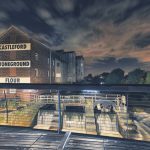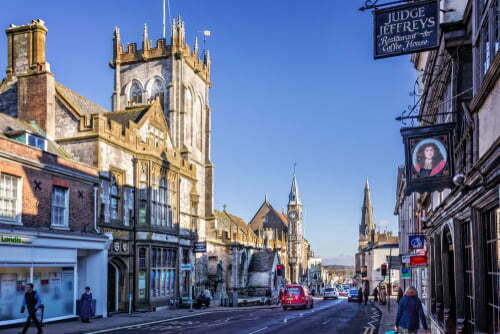
Dorchester in Brief
Dorchester is an ancient market town and civil parish in Dorset, south-west England. Also the county town, it’s located 20 miles (32 km) west of Poole and 7 miles (11 km) north of Weymouth. It also sits on the banks of the River Frome, just to the south of the Dorset Downs. The town is arguably best known for being host to the 17th century ‘Bloody Assizes’ and home to 19th-century author and poet Thomas Hardy. At the 2011 national census, the population of Dorchester was 19,060.
A Fleeting History
Roman Times
The Dorchester area is thought to have been first settled as early as 4000 BC. The large Iron Age hill fort at Maiden Castle was one of pre-Roman Britain’s largest and most important settlements. When the Romans invaded the area in 43 AD, the Durotriges tribe, a Celtic people, occupied the fort. After the Romans defeated the Durotriges they established a garrison town in the area they named Durnovaria.
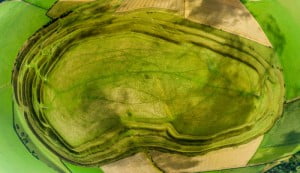
A bird’s eye view of the Iron Age hill fort Maiden Castle. Image credit: David Jeffrey Morgan/Shutterstock.com
By 70 AD, relations between the Romans and the local Celts had achieved relative stability. Subsequently, Durnovaria began to grow beyond the confines of the local garrison. During the 2nd century, the town gained stone buildings, a marketplace, public baths, a water supply, and basic fortification. In the 4th century, the fortification of the town was completed with the construction of an encompassing stonewall. However, the Romans abandoned the town at the end of the 4th century, with the collapse of their western empire.
After the Romans departed Britain, the history of Dorchester through the next several centuries is fairly sketchy. However, most experts think it likely that a small group of local Celts occupied the town. As time went by, people then began to trickle back to the settlement. The local market was eventually re-established and Dorchester became once again became a functioning town.
The Middle Ages
It is thought one of the first Viking raids on British soil took place near Dorchester around 790. The King’s reeve (town official) and a small posse of locals confronted the raiders thinking they were friendly overseas traders. However, the Norsemen showed no mercy, which saw the locals duly slaughtered.
By 864, Dorn-g-weir, as Dorchester was then known, was occupied by new invaders, the Saxons. The interlopers were soon referring to themselves as Dorsaetas, ‘People of the Dor’. The town then became Dornwaraceaster, combining the original Latin name with ‘ceaster’, an Old English word for a military fort. Over time, the written name evolved to Dornceaster, then Dorncester, and finally Dorchester.
By the early 10th century the town had a mint. And by 1086, it had been bestowed the status of a royal borough. By the beginning of the 12th century, the Normans had constructed a castle in the town. However, the castle did not survive. In the early to mid-14th century is thought a Franciscan priory was constructed from ruined castle’s stone. While the priory went the same way as the castle, Dorchester itself began to thrive. By the late Middle Ages, the town had become the main centre of commerce for South Dorset. It had in particular, a flourishing textile industry.
The 16th to 18th Centuries
By 1500, it’s generally thought the population of Dorchester was around 1,000. In the second half of the century, like much of England, the town’s population was blighted by a series of outbreaks of the plague. The town’s first free school was founded by Thomas Hardye, a Dorchester merchant, in 1569.
In 1610, the town was granted its first royal charter. However, a major setback was suffered only 3 years later when much of the town was devastated by fire. The town’s first mayor John Parkyns was appointed in 1629. In the 1630s, many of Dorchester’s puritan population left to emigrate to America. They were encouraged to go by the local vicar, a leading puritan figure, the Reverend John White. The town’s emigrants went on to found the settlement of Dorchester, Massachusetts.
At the outbreak of the Civil War in 1642, the largely puritan Dorchester supported parliament. However, in 1643, the royalists managed to capture Dorchester for the crown. During the next 8 years of the war, the town would change hands several more times. In 1685, Judge Jeffreys presided over the ‘Bloody Assizes’ at Dorchester following the Monmouth Rebellion. The trials were held in the Oak Room of the Antelope Hotel. It saw Jeffreys sentence 271 of the rebels to death, though only 74 were actually executed. The condemned men were hung, drawn and quartered, with their heads being displayed on spikes around the town.
During the 18th century, the town’s once-thriving wool trade went into terminal decline. However, as the town’s wool industry faded, its brewing industry began to prosper.
The 19th & 20th Centuries
In 1801, the year of the first national census, the population of Dorchester was recorded as 2,402. Rapid population growth during this period saw the town expand outside its Roman walls.
In 1834, the pioneering Tolpuddle Martyrs were tried and sentenced at Dorchester to deportation to Australia. The poor agricultural workers’ crime had been nothing more than an attempt to form a trade union. Their 7-year sentences were annulled two years later. However, the rest of the century saw Dorchester make some considerable improvements. In 1835, gaslighting was installed around the town. By 1836, a regular police force had been established. A county hospital opened in 1841, and a museum in 1845. The railway arrived in the town in 1847, when the line to Southampton was completed. A town hall was also built in the same year. By 1860, Dorchester had a water supply and a functioning sewer system.
The town continued to enjoy further improvements throughout the 20th century. It gained an electricity supply in 1901 and the first cinema in 1911. The 1920s, saw the first council houses being built in the town and carried on in earnest through the 1930s. A statue of the town’s most famous son Thomas Hardy was erected in 1931. In 1986, a statue was also erected in the town of the Tolpuddle Martyrs. The Dorchester bypass was completed in 1988, helping to relieve traffic congestion in the town.
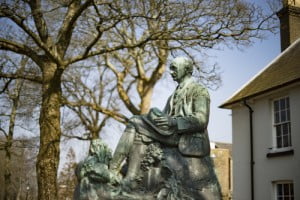
Author Thomas Hardy’s statue in Dorchester. Image credit: Robert Hurworth/Shutterstock.com
The Modern Era
The majority of jobs in Dorchester are in the service sector, where the biggest slice of those is in public administration. Hospitality, including tourism, makes up less than a fifth of the local economy. The town has six small to medium-sized industrial estates but these mostly house light industry, wholesalers, and the service sector. Since 2103, the 12-acre ‘Brewery Square’ redevelopment of the town centre has provided a big boost to the local economy. The project includes retail outlets, residential units, bars, restaurants, hotels, and other public amenities.
Dorchester’s market day is Wednesday. You’ll be able to pick up the usual fresh produce, clothes, plants, flowers, antiques, collectibles, etc. On the fourth Saturday of the month, South Street hosts a typical farmers’ market. There’s also a farmers’ market held at Poundbury’s Queen Mother Square on the first Saturday of the month.
The biggest event in the Dorchester calendar year is the Dorset County Show, held the first week of September The annual agricultural show usually features more than 400 trade stands and the usual array of rustic attractions. Other big happenings include the popular Dorchester Literary Festival held in October. The annual Cider Festival, also very popular, usually takes place in late August or early September. The biennial Dorchester Festival runs for 10 days in mid-September, with the next being scheduled for 2021. It has plenty of free events that include outdoor theatre, dance, and music.
Dorchester is twinned with three European towns, namely Bayeux in France, Lübbecke in Germany, and Holbæk in Denmark.
Getting to Dorchester
If you want to make the journey to Dorchester by car, it conveniently lies at the intersection of the A35 and the A37. Thus, from London, you can take the M3, M27, A31, and finally the A35 to make the 125-mile journey. From the Midlands and the North it’s probably easiest to head to Bath, then take the A39 and A37.
Dorchester has two train stations; Dorchester South and Dorchester West. A regular train service operates from London Waterloo to Dorchester South, via Southampton and Bournemouth. The journey takes around 2 hours 45 minutes. Trains from Gloucester, Bath, and Bristol, all arrive at Dorchester West.
If you fancy making the journey to Dorchester by air then the nearest airports are Bournemouth (BOH) 27 miles away, and Bristol (BRS) 48 miles away. Other major nearby airports include Southampton (SOU) 50 miles, London Heathrow (LHR) 101 miles, and London Gatwick (LGW) 104 miles.
A Famous Son
Thomas Hardy (1840 – 1928) was an internationally renowned writer and poet who was born and spent most of his life in Dorset. He was born on 2 June 1840 in the small hamlet of Higher Bockhampton, about a mile east of Dorchester. His famed 1886 novel ‘The Mayor of Casterbridge’, is said to be largely based on Hardy’s experiences of Dorchester. From 1885 until his death in 1928, he lived at Max Gate, his married home on the outskirts of the town. He was interred in Westminster Abbey but his heart was buried with his first wife Emma Gifford (1912) at his home village of Stinsford.
Did you know?
- Dorchester has been the county town of Dorset since 1305.
- Bayeux in France has been twinned with Dorchester since 1959. In 1944, it was the Dorset Regiment that liberated the town in the allied invasion that eventually ended WW2.
- Prince Charles’ experimental eco-friendly new town ‘Poundbury’ is actually on the outskirts of Dorchester.
- The Hardy Monument at Black Down, close to Dorchester, isn’t dedicated to author Thomas Hardy. It was erected in 1844 in memory of Vice-Admiral Sir Thomas Masterman Hardy, of Nelson’s ”Kiss me Hardy” fame at the Battle of Trafalgar.
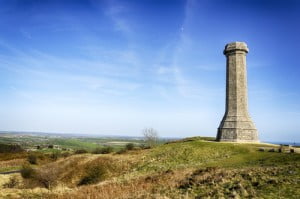
The Hardy Monument at Black Down. Image credit – Helen Hotson/Shutterstock.com
Sport in Dorchester
Dorchester Town FC currently (2021/22) plays its football in the Southern League Premier Division. Nicknamed the Magpies, the club plays home games at the Avenue Stadium, which has a capacity of over 5,000.
Dorchester RFC is an amateur rugby union team that currently plays in the Dorset & Wilts South 1 League. The club plays its home games at Coburg Road.
Dorchester Cricket Club plays in the Dorset Premier League. Their home games are played at the Recreation Ground.
Things to do!
Skaters & Skateboarders
Dorchester Skatepark is a state-of-the-art permanent concrete park. Open every day and free to use, as well as catering for skaters and skateboarders, the park is also suitable for BMXs and scooters.
Mystery and Murder
The Dorchester Murder Mystery Treasure Trail is a fun mystery-themed walk around the town. It’s a great way to get to know Dorchester. The 1.5-mile walk is done in your own time at your own pace but generally takes about 2 hours.
The trail is suitable for all ages.
Hiking & Biking
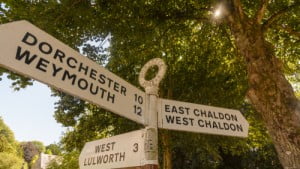
Image credit: Jacek Wojnarowski/Shutterstock.com
A popular route with walkers that passes through Dorchester is the River Froome walk. It begins at Evershot in the Dorset Downs and runs through the outskirts of Dorchester on its way to the sea at Wareham. The trek is 30 miles in total but you can obviously start and finish the walk where you want.
Another popular hike is the two-mile short-walk is to the 45-acre site of Maiden Castle. The site of the largest hillfort in England is just two miles south of Dorchester. There are some great views from the high-point.
There are any amount of long and short-established cycling routes that pass through or loop around Dorchester. An example is the Chesil Beach Loop, which passes through Dorchester South. The 38-mile route has some great views and would take an average rider a little over 3 hours.
Shopping, Eating, and Drinking
Since 2013, Brewery Square has been the main entertainment and retail hub of Dorchester. The attractive, modern complex houses an array of shops, eateries, restaurants, and bars, as well as residential buildings and a cinema.
Things to see
A Museum Lover?
If you happen to like museums, then Dorchester is definitely the place for you. These include the Roman Town House, the Dinosaur Museum, the Terracotta Warriors Museum, the Dorset Teddy Bear Museum, the Keep Military Museum, and the Dorset County Museum. There’s also the Tutankhamun Exhibition, which is a permanent display containing replicas of many original artefacts.
Houses & Gardens
Athelhampton House and Garden is one of the country’s finest examples of a Tudor country residence. The stunning grounds and gardens were designed and laid out in the Victorian era. Located 6 miles from Dorchester, the house is open Sundays to Thursdays, March through to October.
One of the best things to do around Dorchester is visit to Kingston Maurward Gardens and Animal Park. The 16th-century manor house is a private college, so not generally open to the public. However, it’s set in stunning gardens, and a surrounding country estate, which houses an animal park. There’s a good collection of the usual farmyard animals as well as more exotic species such as alpacas, rheas, wallabies, etc.
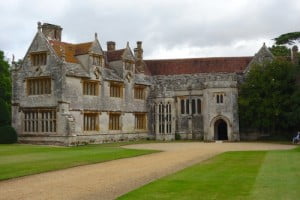
Athelhampton House. Image credit: Chris Jenner/Shutterstock.com
The Thomas Hardy Trail
The ‘Thomas Hardy Trail’ traces the footsteps of Thomas Hardy across Dorset. He spent much of his life at Hardy Cottage, and Max Gate, both about a mile from Dorchester. Hardy’s Cottage, his birthplace, is located at Higher Bockhampton and was built by his great-grandfather in 1800. The secluded cottage has seen little alteration since that time. Max Gate was Thomas Hardy’s married home between 1885 and 1928, and where he wrote some of his most famous works. The house was designed by Hardy himself and built by his brother. Like Hardy’s Cottage, Max House is about a mile from Dorchester and owned by the National Trust. It’s also been preserved to be as much as it was in Hardy’s day.
Poundbury Village
The Duchy of Cornwall’s model village of Poundbury is located just on the outskirts of Dorchester. The development began in the mid-1990s as an eco-friendly alternative to the bog-standard ‘New Town’. The village has a mix of traditionally constructed buildings that help to create an oldy worldly atmosphere. The village is also home to several independent local businesses, that include tearooms, a chocolate maker, and a garden centre. Well worth a visit!
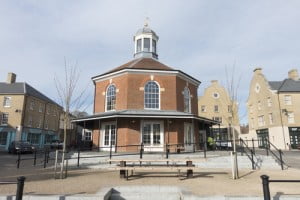
The model village of Poundbury. Image credit: Robert Hurworth/Shutterworth.com
Where to stay?
Dorchester and the surrounding area provide a great range of accommodation with something to suit every budget. You should be able to find everything from campsites to luxury hotels in the Dorchester area. Holiday cottages, farm stays, stylish villas, B & B’s, and inns, can also be found.
Moving to Dorchester?
Properties in Dorchester have sold for an average price of £327,000 over the last year (Aug 2021). During that period, the best sellers in Dorchester were flats, which sold for an average price of £224,000. Terraced properties sold for an average of £330,000, semi-detached fetched £355,500, and detached properties £497,250. Dorchester’s average property selling price over the last year was 2% up from the previous year.
Thinking about a Staycation?
Are you thinking of holidaying in the UK sometime soon? If so, why not check out some of our other travel guides for some staycation ideas? I think you’ll be surprised at the variety of great things to do throughout the UK.
Header image credit: Nigel Jarvis/Shutterstock.com
Why Not Take the Dorchester Quiz?
Quiz Maker – powered by Riddle

